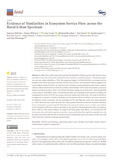JavaScript is disabled for your browser. Some features of this site may not work without it.
| dc.contributor.author | Welivita, Indunee | |
| dc.contributor.author | Willcock, Simon | |
| dc.contributor.author | Lewis, Amy | |
| dc.contributor.author | Bundhoo, Dilshaad | |
| dc.contributor.author | Brewer, Timothy R. | |
| dc.contributor.author | Cooper, Sarah | |
| dc.contributor.author | Lynch, Kenneth | |
| dc.contributor.author | Mekala, Sneha | |
| dc.contributor.author | Mishra, Prajna Paramita | |
| dc.contributor.author | Venkatesh, Kongala | |
| dc.contributor.author | Rey Vicario, Dolores | |
| dc.contributor.author | Hutchings, Paul | |
| dc.date.accessioned | 2021-04-28T15:51:28Z | |
| dc.date.available | 2021-04-28T15:51:28Z | |
| dc.date.issued | 2021-04-17 | |
| dc.identifier.citation | Welivita I, Willcock S, Lewis A, et al., (2021) Evidence of similarities in ecosystem service flow across the rural–urban spectrum. Land, Volume 10, Issue 4, April 2021, Article number 430 | en_UK |
| dc.identifier.issn | 2073-445X | |
| dc.identifier.uri | https://doi.org/10.3390/land10040430 | |
| dc.identifier.uri | http://dspace.lib.cranfield.ac.uk/handle/1826/16629 | |
| dc.description.abstract | In 2006, the world’s population passed the threshold of being equally split between rural and urban areas. Since this point, urbanisation has continued, and the majority of the global population are now urban inhabitants. With this ongoing change, it is likely that the way people receive benefits from nature (ecosystem services; ES) has also evolved. Environmental theory suggests that rural residents depend directly on their local environment (conceptualised as green-loop systems), whereas urban residents have relatively indirect relationships with distant ecosystems (conceptualised as red-loop systems). Here, we evaluate this theory using survey data from >3000 households in and around Hyderabad, India. Controlling for other confounding socioeconomic variables, we investigate how flows of 10 ES vary across rural, peri-urban and urban areas. For most of the ES we investigated, we found no statistical differences in the levels of direct or indirect use of an ecosystem, the distance to the ecosystem, nor the quantities of ES used between rural and urban residents (p > 0.05). However, our results do show that urban people themselves often travel shorter distances than rural people to access most ES, likely because improved infrastructure in urban areas allows for the transport of ES from wider ecosystems to the locality of the beneficiaries’ place of residence. Thus, while we find some evidence to support red-loop–green-loop theory, we conclude that ES flows across the rural-urban spectrum may show more similarities than might be expected. As such, the impact of future urbanisation on ES flows may be limited, because many flows in both rural and urban areas have already undergone globalisation | en_UK |
| dc.language.iso | en | en_UK |
| dc.publisher | MDPI | en_UK |
| dc.rights | Attribution 4.0 International | * |
| dc.rights.uri | http://creativecommons.org/licenses/by/4.0/ | * |
| dc.subject | urbanisation | en_UK |
| dc.subject | nature’s contributions to people | en_UK |
| dc.subject | India | en_UK |
| dc.subject | peri-urban | en_UK |
| dc.subject | red-loop | en_UK |
| dc.subject | green-loop | en_UK |
| dc.subject | provisioning | en_UK |
| dc.subject | cultural | en_UK |
| dc.title | Evidence of similarities in ecosystem service flow across the rural–urban spectrum | en_UK |
| dc.type | Article | en_UK |
Files in this item
The following license files are associated with this item:
This item appears in the following Collection(s)
-
Staff publications (SWEE) [2835]

